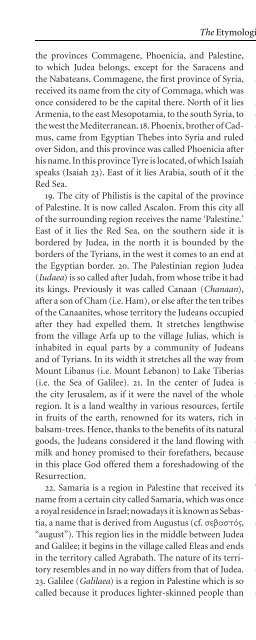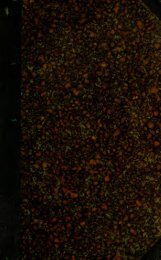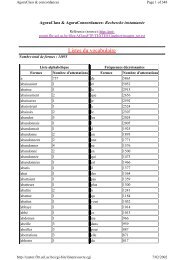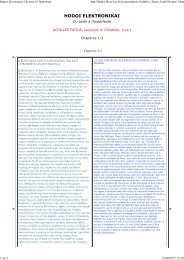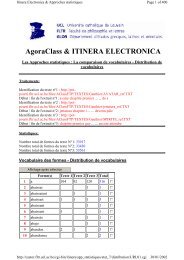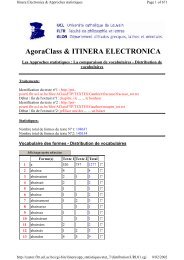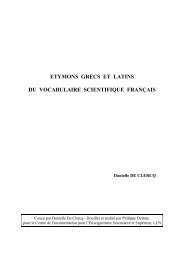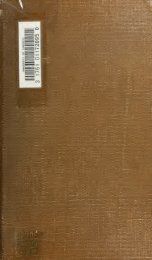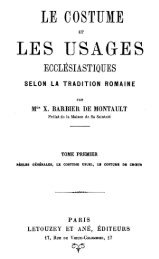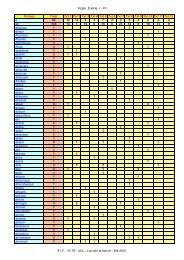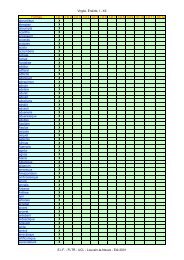The Etymologies of Isidore of Seville - Pot-pourri
The Etymologies of Isidore of Seville - Pot-pourri
The Etymologies of Isidore of Seville - Pot-pourri
Create successful ePaper yourself
Turn your PDF publications into a flip-book with our unique Google optimized e-Paper software.
the provinces Commagene, Phoenicia, and Palestine,<br />
to which Judea belongs, except for the Saracens and<br />
the Nabateans. Commagene, the first province <strong>of</strong> Syria,<br />
received its name from the city <strong>of</strong> Commaga, which was<br />
once considered to be the capital there. North <strong>of</strong> it lies<br />
Armenia, to the east Mesopotamia, to the south Syria, to<br />
the west the Mediterranean. 18. Phoenix, brother <strong>of</strong> Cadmus,<br />
came from Egyptian <strong>The</strong>bes into Syria and ruled<br />
over Sidon, and thisprovincewas called Phoenicia after<br />
his name. In this province Tyre is located, <strong>of</strong> which Isaiah<br />
speaks (Isaiah 23). East <strong>of</strong> it lies Arabia, south <strong>of</strong> it the<br />
Red Sea.<br />
19. <strong>The</strong> city <strong>of</strong> Philistis is the capital <strong>of</strong> the province<br />
<strong>of</strong> Palestine. It is now called Ascalon. From this city all<br />
<strong>of</strong> the surrounding region receives the name ‘Palestine.’<br />
East <strong>of</strong> it lies the Red Sea, on the southern side it is<br />
bordered by Judea, in the north it is bounded by the<br />
borders <strong>of</strong> the Tyrians, in the west it comes to an end at<br />
the Egyptian border.20. <strong>The</strong> Palestinian region Judea<br />
(Iudaea)issocalled after Judah, from whose tribe it had<br />
its kings. Previously it was called Canaan (Chanaan),<br />
after a son <strong>of</strong> Cham (i.e. Ham), or else after the ten tribes<br />
<strong>of</strong> the Canaanites, whose territory the Judeans occupied<br />
after they had expelled them. It stretches lengthwise<br />
from the village Arfa up to the village Julias, which is<br />
inhabited in equal parts by a community <strong>of</strong> Judeans<br />
and <strong>of</strong> Tyrians.Initswidthitstretchesallthewayfrom<br />
Mount Libanus (i.e. Mount Lebanon) to Lake Tiberias<br />
(i.e. the Sea <strong>of</strong> Galilee). 21. Inthecenter <strong>of</strong> Judea is<br />
the city Jerusalem, as if it were the navel <strong>of</strong> the whole<br />
region. It is a land wealthy in various resources, fertile<br />
in fruits <strong>of</strong> the earth, renowned for its waters, rich in<br />
balsam-trees. Hence, thanks to the benefits <strong>of</strong> its natural<br />
goods, the Judeans considered it the land flowing with<br />
milk and honey promised to their forefathers, because<br />
in this place God <strong>of</strong>fered them a foreshadowing <strong>of</strong> the<br />
Resurrection.<br />
22. Samaria is a region in Palestine that received its<br />
name from a certain city called Samaria, which was once<br />
aroyal residence in Israel; nowadays it is known as Sebastia,<br />
a name that is derived from Augustus (cf. ,<br />
“august”). This region lies in the middle between Judea<br />
and Galilee; it begins in the village called Eleas and ends<br />
in the territory called Agrabath. <strong>The</strong> nature <strong>of</strong> its territory<br />
resembles and in no way differs from that <strong>of</strong> Judea.<br />
23.Galilee (Galilaea)isaregion in Palestine which is so<br />
called because it produces lighter-skinned people than<br />
<strong>The</strong> <strong>Etymologies</strong> XIV.iii.18–iii.30 287<br />
Palestine does (cf. , “milk”). It has two parts, an<br />
upper and a lower, which are nevertheless connected<br />
and border on Syria and Phoenicia. Its earth is rich, fertile,<br />
and rather abundant in produce. 24. Pentapolis is<br />
aregion located where Arabia borders on Palestine. It<br />
derives its name from the five wicked cities that were<br />
consumed by heavenly fire (see Wisdom 10:6, Vulgate,<br />
and cf. v.5 below). Once this land was more fertile than<br />
Jerusalem, but today it is deserted and scorched, for due<br />
to the wickedness <strong>of</strong> its inhabitants fire descended from<br />
heaven that reduced this region to eternal ashes (Genesis<br />
19:24–25). 25.Akind <strong>of</strong> shadow and image <strong>of</strong> it is visible<br />
to this day in its ashes and trees, for in this area there<br />
is flourishing fruit with such an appearance <strong>of</strong> ripeness<br />
that it makes one want to eat it, but if you gather it, it<br />
falls apart and dissolves in ashes and gives <strong>of</strong>f smoke as<br />
if it were still burning. 26. Nabathea is a region named<br />
after Nabaioth, son <strong>of</strong> Ishmael. It lies between Judea and<br />
Arabia; rising from the Euphrates it stretches to the Red<br />
Sea – it is part <strong>of</strong> Arabia.<br />
27. Egypt (Aegyptus), which was formerly called<br />
‘Aeria,’ later took its name from Aegyptus, brother <strong>of</strong><br />
Danaus, who reigned there. In the east it is adjoined<br />
by Syria and the Red Sea, to the west lies Libya, in the<br />
north the Mediterranean, while in the south it extends<br />
toward the interior, reaching Ethiopia, a region unaccustomed<br />
to rain and unacquainted with downpours.<br />
28. <strong>The</strong>Nile alone waters it when it overflows and renders<br />
it fertile with its flood; whence it is rich in produce<br />
and feeds many parts <strong>of</strong> the earth with grain. Furthermore,<br />
it overflows with other articles <strong>of</strong> trade to such an<br />
extent that it fills the world with indispensable merchandise.<br />
Egypt ends at Canopea, named after the helmsman<br />
<strong>of</strong> Menelaos, Canopus, who is buried on the island that<br />
marks the beginning <strong>of</strong> Libya and the mouth <strong>of</strong> the Nile.<br />
29.Seres is a city <strong>of</strong> the east after which both the Seres<br />
and their region (i.e. China and East Asia) are named.<br />
<strong>The</strong> area bends from the Scythian Ocean and the Caspian<br />
Sea to the eastern Ocean. It is rich in a renowned foliage,<br />
from which silk-fleece is gathered, which the Seres sell to<br />
other peoples for the manufacture <strong>of</strong> garments. 30.<strong>The</strong><br />
river Bactrus itself gave its name to Bactria. <strong>The</strong> parts <strong>of</strong><br />
it that are further out are surrounded by the range <strong>of</strong> the<br />
Propanisus, while those facing us terminate at the source<br />
<strong>of</strong> the river Indus; the river Ochus is the boundary for<br />
the remaining parts. Bactria exports camels <strong>of</strong> the greatest<br />
strength, whose feet never wear out.


